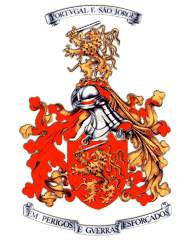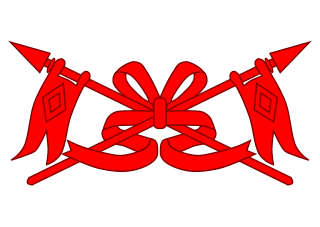
The Angolan Armed Forces or FAA is the military of Angola. The FAA consist of the Angolan Army, the Angolan Navy and the National Air Force of Angola. Reported total manpower in 2021 was about 107,000. The FAA is headed by the Chief of the General Staff António Egídio de Sousa Santos since 2018, who reports to the minister of National Defense, currently João Ernesto dos Santos.

The Brazilian Army is the branch of the Brazilian Armed Forces responsible, externally, for defending the country in eminently terrestrial operations and, internally, for guaranteeing law, order and the constitutional branches, subordinating itself, in the Federal Government's structure, to the Ministry of Defense, alongside the Brazilian Navy and Air Force. The Military Police and Military Firefighters Corps are legally designated as reserve and auxiliary forces to the army. Its operational arm is called Land Force. It is the largest army in South America and the largest branch of the Armed Forces of Brazil.

The Structure of the Argentine Army follows below. As of 2020 the active force of the Argentine Army includes a total of eleven brigades:

The Portuguese Army is the land component of the Armed Forces of Portugal and is also its largest branch. It is charged with the defence of Portugal, in co-operation with other branches of the Armed Forces. With its origins going back to the 12th century, it can be considered one of the oldest active armies in the world.

The Brigada de Reacção Rápida is a unit of the Portuguese Army which was known as BAI – Brigada Aerotransportada Independente until 2006. Its different units are highly trained Paratroopers, Commandos and Special Operations Troops capable of responding to threats in any part of continental Portugal or any other Portuguese overseas territory with quick deployment by air, sea or land. This brigade is the most requested by the Portuguese Government to fulfill international assignments due to its experience and multi-role capability.
The MAX 1.2 AC, —previously known as MSS 1.2 AC— is a Brazilian anti-tank guided missile (ATGM). Operated by infantry or vehicles, the system consists of a reloadable launch tube, laser-guided missile and firing unit, as well as a simulator and testing equipment. It was developed out of Oto Melara's “Missile Anti-Carro della Fanteria”, which was rejected by the Italian Army. Brazilian involvement began in 1986 and it has since then been tested and redesigned by the Brazilian Army's research institutes and a series of Brazilian companies.
The Amazon Military Command is one of eight Military Commands of the Brazilian Army. The Amazon Military Command is responsible for the defence of the Amazon Basin. Four Infantry Brigades specializing in Jungle warfare, one construction Engineer Brigade and one Military Regional Command are subordinated to the CMA. Its area of responsibility covers the states of Amazonas, Acre, Roraima and Rondônia.
The Eastern Military Command is one of eight Military Commands of the Brazilian Army. The Eastern Military Command is responsible for the defense of the states Rio de Janeiro, Minas Gerais, and Espírito Santo. A Parachutist Brigade and two Infantry Brigades are assigned to the 1st Army Division, which is the maneuver unit of the CML. Two Military Regional Commands are subordinated to the CML for administrative purposes.
The Northeastern Military Command is one of the eight Military Commands of the Brazilian Army. The Northeastern Military Command is responsible for the defense of the states Bahia, Sergipe, Rio Grande do Norte, Paraíba, Pernambuco, Alagoas, Ceará, Piauí, and Maranhão. Three Military Regional Commands are subordinated to the CMNE for administrative purposes.

The Western Military Command is one of the eight Military Commands of the Brazilian Army. The Western Military Command is responsible for the defense of the states Mato Grosso and Mato Grosso do Sul.
The Planalto Military Command is one of the eight Military Commands of the Brazilian Army. The Planalto Military Command is responsible for the defense of the state Goiás, most of the state of Tocantins, the Federal District with the capital Brasília, and the Triângulo Mineiro region of the state of Minas Gerais.
The Southeastern Military Command is one of eight Military Commands of the Brazilian Army. It is responsible for the defence of the state of São Paulo.
The Southern Military Command is one of eight Military Commands of the Brazilian Army. The Southern Military Command is responsible for the defence of the states of Rio Grande do Sul, Paraná and Santa Catarina.

The Lithuanian Land Forces (LLF) form the backbone of the Lithuanian Armed Forces, capable of acting as an integral part of NATO forces. Lithuanian Land Forces consist of three brigades, the Engineer Battalion, and the National Defence Volunteers Division.

The Intervention Brigade or BrigInt is an infantry brigade in service with the Portuguese Army. It was created in 2006 from the Light Intervention Brigade, which was itself the heir of the former Special Forces Brigade.

The 12th Light Infantry Brigade (Airmobile) (Portuguese: 12.ª Brigada de Infantaria Leve (Aeromóvel), 12ª Bda Inf L (Amv)) is a large unit of the Brazilian Army based in Caçapava, São Paulo. It is subordinated to the 2nd Army Division. Since 1995 its elements have been transported by Army Aviation helicopters, being able to quickly operate in any part of Brazil's territory.

The Cuban Revolutionary Army serve as the ground forces of Cuba. Formed in 1868 during the Ten Years' War, it was originally known as the Cuban Constitutional Army. Following the Cuban Revolution, the revolutionary military forces was reconstituted as the national army of Cuba by Fidel Castro in 1960. The army is a part of the Cuban Revolutionary Armed Forces which was founded around that time.

The Brazilian cavalry is one of the branches that make up the Brazilian Army. It operates in armored vehicles and, like the infantry, has the role of directly confronting the enemy, but with distinct missions such as reconnaissance and vanguard. It is organized into regiments and squadrons, which are equivalent to the infantry's battalions and companies. Its main types are tank, mechanized, armored and guard. Its troops serve in vehicle crews or as fusiliers on board, who can also fight on foot.




























